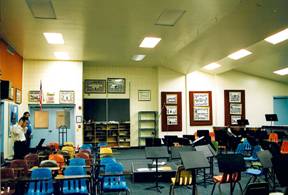
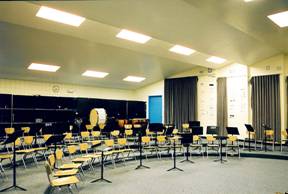
[ Lay Language Paper Index | Press Room ]
Hyun Paek
Siebein Associates, Inc.
625 NW 60th Street, Suite C, Gainesville, Florida 32607
Gary W. Siebein
University of Florida
Gainesville, FL 32611-5702
Popular version of paper 4aAA2
Presented Friday morning, November 30, 2007
154th ASA Meeting, New Orleans, LA
Nationwide, there are increasing numbers of Workers Compensation Claims and law suits filed by music instructors against school boards for alleged hearing loss due to excessive noise levels encountered on the job. The cause is usually attributed to rooms where instructors work all day with low ceilings and small amounts of sound absorbent materials.
This is especially a problem in schools that were built more than two to three decades ago. The use of the music rooms have changed over the past several decades from classical ensembles to marching bands, but the rooms have not. Rooms that were designed to have the ‘liveness’ suitable for classical music instruments were now occupied by louder bands with increased numbers of percussion and brass instruments.
This problem existed for several schools in two different counties in Florida. The band rooms of the different schools were almost identical since they were copied from prototypes. The band rooms were trapezoidal in shape with relatively low, angled gypsum board ceilings with few sound absorbing materials installed.


Music instructors and students complained of headaches from excessive noise levels during classes. Instructors also could not hear students well because of ‘muddiness’ of sound caused by long reverberation times of over 1 second.
Acoustical measurements of reverberations times, overall sound levels, clarity index, and reflected sounds were used to identify the causes of the perceived problems. The renovation was to be undertaken as economically and quickly as possible. Therefore, the acoustical design included replacing the hard continuous ceiling with a ceiling gird system with pre-fabricated-diffusing panels that provide cross room reflections that allow students to hear each other and the instructor to hear individual students; installing high performance ceiling tiles that reduce excessively loud ceiling reflections; raising the ceiling height to reduce excessive sound levels; and strategically placing sound diffusing and sound absorbent materials on the walls to reduce reverberation, excessive loudness and acoustic defects.
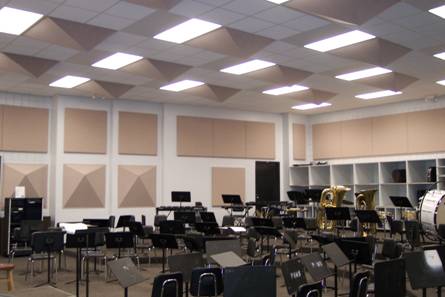

Post-construction acoustical measurements, as well as discussions with music instructors, revealed that while both reverberation times and loudness decreased, the early sound energy reflected across the room increased and resulted in improved musical communication among students and instructors.
The ‘impulse response’ graph below compares the acoustical conditions before (blue) and after (black) the renovations. The vertical ‘spikes’ are sound energy that arrives at the listener’s ears (in this case, a microphone used during a computer aided acoustical measurement) as time passes. Before the renovations, the blue ‘spikes’ lose energy over a longer period of time, because they are repeatedly reflecting off of hard walls and ceilings. The impulse response after the renovation shows a much rapid decay of reflected sound energy.
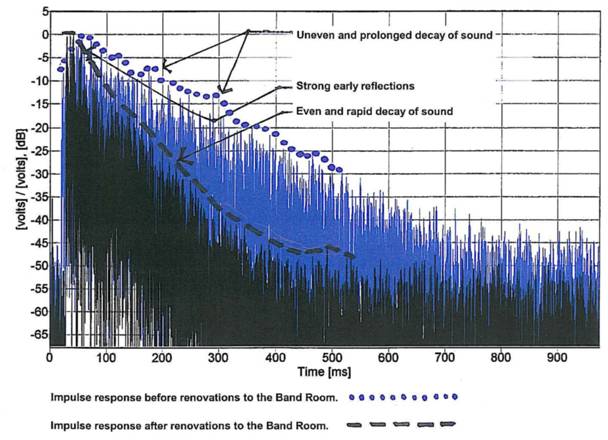
The reverberation times have also been reduced significantly from over 1 second in the mid-frequencies, to approximately 0.5 seconds, providing clarity of sounds so that both students can hear each other well during rehearsals and so that instructors can hear individual instruments and distinguish every note clearly.
The graph below shows that the clarity index (C-80, which measures the logarithmic ratio of early sound energy arriving at a listener’s ears within the first 80 milliseconds to the late energy arriving after 80 milliseconds) of several positions in three band rooms increased from 0 to 5 in the mid frequencies to 8 to 17. This is a significant increase in clarity of sounds produced in the room.
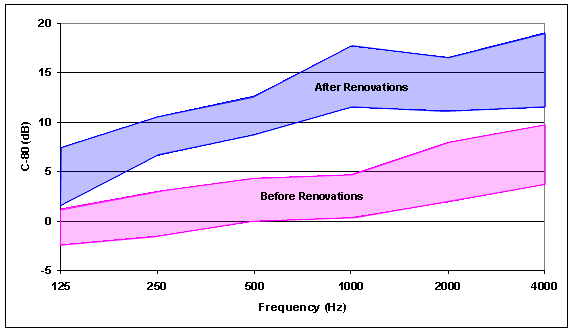
The proper acoustical renovation of rooms for music instruction can change rooms that have extreme acoustical problems into those students and instructors are pleased to rehearse in. “We can actually hear well and play beautifully now,” exclaimed a band instructor who teaches in one of the renovated rooms.
[ Lay Language Paper Index | Press Room ]